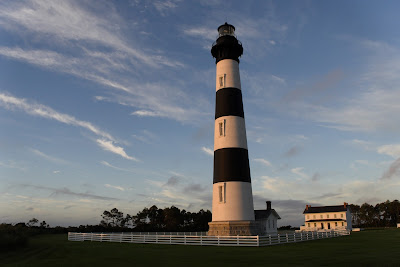this past summer Linda and I volunteered with the National Park Service at Bodie Lighthouse in the outer banks of North Carolina. Bodie is a preserved lighthouse and so it remains much as it was when being manned by a light keeper. opened in 1872 it filled a void in the number of lighthouses along the eastern coast of the USA. the demand for a lighthouse in this area came from the ship owners and captains who sailed from the industrial areas up north to the agricultural areas in the south. this era of reconstruction followed the civil war, which was responsible for the destruction of other major transportation channels, ocean vessels assumed a very important role in getting goods and supplies to and from the previously warring factions.
the building shown here is the third light to be erected in this area. the first was built too close to the ocean and after a short time fell over and collapsed. the second one was a victim of the civil war being blown up by retreating confederate soldiers. fortunately, the Fresnel lens was salvaged and reused in other locations. this third attempt was properly located away from the shore and built by the contractor who had just recently finished the light house at Cape Hatteras. using double wall design the base is over 6 feet think tapering to over 2 feet at the top. we climbed the 219 steps 2x or 3x each day assisting visitors and answering their questions.

 |
| each light house has its own light signature as well as a distinctive color. Bodie started out as a solid light always on and later when all lights were re coded took on its current and distinctive 3 shorts on followed by a long off. |
 |
| the light was not open to the public for many years ans as a result suffered from a lack of maintenance. when first opened in 1973 the stairway and hand rails were in very poor shape suffering from extensive rust and in several areas collapse. the Park Service removed the stairs and the other cast iron supports and braces giving them to a pattern maker in New York for him to replicate the items. they first made patterns of each piece and using the old cast iron along with new iron recast the stairs and rails. the recast pieces were then installed in their original places for public use. |
 |
| looking up the middle of the lighthouse the delicate spiral staircase is a work of art. |
 |
| because the building tapers, the stairs must taper also. the double curve demonstrates the skill of the workmen and craftsmen in the late 1800's. |
 |
| each stair tread was patterned and recast for additional strength. |
 |
| from the top of the light the old light keeper's house is visible. |
 |
| light keepers were required to live on site. they were provided with housing, food and stipend for their services. many of them brought their families, including children, to live with them. from Bodie wives and children would board a small boat and row over to the mainland to go to school. Later when roads were graded to the light, the children would ride in a buggy to school. |
 |
| on a clear night the stars make a brilliant backdrop for the light house. |

 |
| morning sun at the light. |
 |
| the Fresnel lens, invented by a french engineer of the same name, was the most effective lens used in lighthouses. using this engineered lens the light from oil lamps could be seen 19 mile out to sea, this warning beacon saved hundreds of lives and millions of dollars of goods. |
 |
| today, instead of oil lamps, the lighthouses use 1000watt electric bulbs shown here. the light signature is obtained by turning the power on and off. |
 |
| the cast bronze brackets hold and angle the prisms for maximum efficiency. during the reconstruction of the building this lens was dissembled, cleaned and reinstalled. the lens in use today is the same one installed in 1872. |
 |
| this marker identifies the location and commemorates its dedication. the name is misspelled. proper spelling is Bodie, based on old records and family confirmation. |
 |
| The oil room and keepers office is in the small building attached to the light. |
 |
| brief description of how a light works. |
 |
| sunsets were often spectacular |




















No comments:
Post a Comment